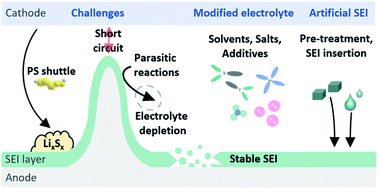The lithium metal anode in Li–S batteries: challenges and recent progress
Abstract
As strenuous research works approach the theoretical limits of the lithium-ion battery, the need to exploit more sustainable chemistries has emerged as a primary concern. The development of the lithium–sulfur (Li–S) battery offers an energy density of 2567 W h kg−1, reflecting an up to three to fivefold enhancement against the state-of-the-art Li-ion device. Solving the critical degradation of the metal anode and suppressing correlated side reactions in the Li–S cell represent, however, pivotal steps towards commercial consideration. In light of the unique Li–S electrochemistry, we examine herein the technical challenges of the lithium metal anode, including the dendritic lithium nucleation and growth during Li plating, and the stabilization of the solid electrolyte interphase (SEI). We revisit key contributions to establish a guideline of crucial factors determining the stability of the anode and its correlation with the electrolyte selection, electrode current density, and the effect of the shuttle of polysulfide intermediate species. Most importantly, our review delivers a comprehensive comparison of introduced strategies for the metal surface protection (including electrolyte-modification-based approaches and metal surface coating), along with a theoretical understanding and analysis of the underlying methodologies. This review sheds light on future opportunities towards a practical application of Li–S batteries, while stimulating progress in the exploitation of lithium metal anodes in parallel technologies in the development of energy storage for a sustainable future (266 citations).



 Please wait while we load your content...
Please wait while we load your content...